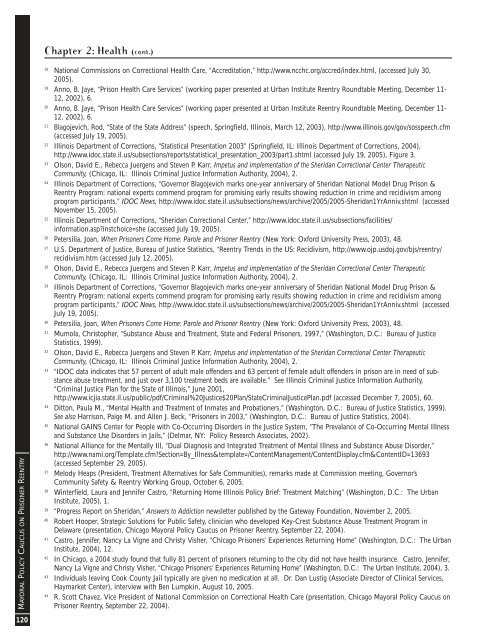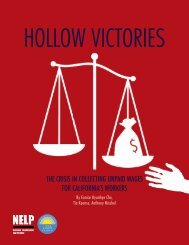Rebuilding Lives. Strengthening Communities.
Rebuilding Lives. Strengthening Communities.
Rebuilding Lives. Strengthening Communities.
You also want an ePaper? Increase the reach of your titles
YUMPU automatically turns print PDFs into web optimized ePapers that Google loves.
Chapter 2: Health (cont.)<br />
MAYORAL POLICY CAUCUS ON PRISONER REENTRY<br />
18<br />
National Commissions on Correctional Health Care, “Accreditation,” http://www.ncchc.org/accred/index.html, (accessed July 30,<br />
2005).<br />
19<br />
Anno, B. Jaye, “Prison Health Care Services” (working paper presented at Urban Institute Reentry Roundtable Meeting, December 11-<br />
12, 2002), 6.<br />
20<br />
Anno, B. Jaye, “Prison Health Care Services” (working paper presented at Urban Institute Reentry Roundtable Meeting, December 11-<br />
12, 2002), 6.<br />
21<br />
Blagojevich, Rod, “State of the State Address” (speech, Springfield, Illinois, March 12, 2003), http://www.illinois.gov/gov/sosspeech.cfm<br />
(accessed July 19, 2005).<br />
22<br />
Illinois Department of Corrections, “Statistical Presentation 2003” (Springfield, IL: Illinois Department of Corrections, 2004),<br />
http://www.idoc.state.il.us/subsections/reports/statistical_presentation_2003/part1.shtml (accessed July 19, 2005), Figure 3.<br />
23<br />
Olson, David E., Rebecca Juergens and Steven P. Karr, Impetus and implementation of the Sheridan Correctional Center Therapeutic<br />
Community, (Chicago, IL: Illinois Criminal Justice Information Authority, 2004), 2.<br />
24<br />
Illinois Department of Corrections, “Governor Blagojevich marks one-year anniversary of Sheridan National Model Drug Prison &<br />
Reentry Program: national experts commend program for promising early results showing reduction in crime and recidivism among<br />
program participants,” IDOC News, http://www.idoc.state.il.us/subsections/news/archive/2005/2005-Sheridan1YrAnniv.shtml (accessed<br />
November 15, 2005).<br />
25<br />
Illinois Department of Corrections, “Sheridan Correctional Center,” http://www.idoc.state.il.us/subsections/facilities/<br />
information.aspinstchoice=she (accessed July 19, 2005).<br />
26<br />
Petersilia, Joan, When Prisoners Come Home: Parole and Prisoner Reentry (New York: Oxford University Press, 2003), 48.<br />
27<br />
U.S. Department of Justice, Bureau of Justice Statistics, “Reentry Trends in the US: Recidivism, http://www.ojp.usdoj.gov/bjs/reentry/<br />
recidivism.htm (accessed July 12, 2005).<br />
28<br />
Olson, David E., Rebecca Juergens and Steven P. Karr, Impetus and implementation of the Sheridan Correctional Center Therapeutic<br />
Community, (Chicago, IL: Illinois Criminal Justice Information Authority, 2004), 2.<br />
29<br />
Illinois Department of Corrections, “Governor Blagojevich marks one-year anniversary of Sheridan National Model Drug Prison &<br />
Reentry Program: national experts commend program for promising early results showing reduction in crime and recidivism among<br />
program participants,” IDOC News, http://www.idoc.state.il.us/subsections/news/archive/2005/2005-Sheridan1YrAnniv.shtml (accessed<br />
July 19, 2005).<br />
30<br />
Petersilia, Joan, When Prisoners Come Home: Parole and Prisoner Reentry (New York: Oxford University Press, 2003), 48.<br />
31<br />
Mumola, Christopher, “Substance Abuse and Treatment, State and Federal Prisoners, 1997,” (Washington, D.C.: Bureau of Justice<br />
Statistics, 1999).<br />
32<br />
Olson, David E., Rebecca Juergens and Steven P. Karr, Impetus and implementation of the Sheridan Correctional Center Therapeutic<br />
Community, (Chicago, IL: Illinois Criminal Justice Information Authority, 2004), 2.<br />
33<br />
“IDOC data indicates that 57 percent of adult male offenders and 63 percent of female adult offenders in prison are in need of substance<br />
abuse treatment, and just over 3,100 treatment beds are available.” See Illinois Criminal Justice Information Authority,<br />
“Criminal Justice Plan for the State of Illinois,” June 2001,<br />
http://www.icjia.state.il.us/public/pdf/Criminal%20Justice$20Plan/StateCriminalJusticePlan.pdf (accessed December 7, 2005), 60.<br />
34<br />
Ditton, Paula M., “Mental Health and Treatment of Inmates and Probationers,” (Washington, D.C.: Bureau of Justice Statistics, 1999).<br />
See also Harrison, Paige M. and Allen J. Beck, “Prisoners in 2003,” (Washington, D.C.: Bureau of Justice Statistics, 2004).<br />
35<br />
National GAINS Center for People with Co-Occurring Disorders in the Justice System, “The Prevalance of Co-Occurring Mental Illness<br />
and Substance Use Disorders in Jails,” (Delmar, NY: Policy Research Associates, 2002).<br />
36<br />
National Alliance for the Mentally Ill, “Dual Diagnosis and Integrated Treatment of Mental Illness and Substance Abuse Disorder,”<br />
http://www.nami.org/Template.cfmSection=By_Illness&template=/ContentManagement/ContentDisplay.cfm&ContentID=13693<br />
(accessed September 29, 2005).<br />
37<br />
Melody Heaps (President, Treatment Alternatives for Safe <strong>Communities</strong>), remarks made at Commission meeting, Governor’s<br />
Community Safety & Reentry Working Group, October 6, 2005.<br />
38<br />
Winterfield, Laura and Jennifer Castro, “Returning Home Illinois Policy Brief: Treatment Matching” (Washington, D.C.: The Urban<br />
Institute, 2005), 1.<br />
39<br />
“Progress Report on Sheridan,” Answers to Addiction newsletter published by the Gateway Foundation, November 2, 2005.<br />
40<br />
Robert Hooper, Strategic Solutions for Public Safety, clinician who developed Key-Crest Substance Abuse Treatment Program in<br />
Delaware (presentation, Chicago Mayoral Policy Caucus on Prisoner Reentry, September 22, 2004).<br />
41<br />
Castro, Jennifer, Nancy La Vigne and Christy Visher, “Chicago Prisoners’ Experiences Returning Home” (Washington, D.C.: The Urban<br />
Institute, 2004), 12.<br />
42<br />
In Chicago, a 2004 study found that fully 81 percent of prisoners returning to the city did not have health insurance. Castro, Jennifer,<br />
Nancy La Vigne and Christy Visher, “Chicago Prisoners’ Experiences Returning Home” (Washington, D.C.: The Urban Institute, 2004), 3.<br />
43<br />
Individuals leaving Cook County Jail typically are given no medication at all. Dr. Dan Lustig (Associate Director of Clinical Services,<br />
Haymarket Center), interview with Ben Lumpkin, August 10, 2005.<br />
44<br />
R. Scott Chavez, Vice President of National Commission on Correctional Health Care (presentation, Chicago Mayoral Policy Caucus on<br />
Prisoner Reentry, September 22, 2004).<br />
120
















